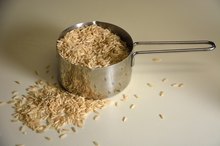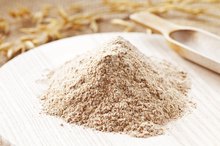Long-Term Health Impact of Bromated Flour
You may have most likely consumed bromated flour without ever knowing about it. Bromated flour is so-called because it contains potassium bromate, which is a potential cancer-causing chemical. The long-term health impact is hard to determine, but it’s still an important issue for you to know about for your ongoing health.
Bromated Flour
Potassium bromate is a chemical additive used in flour to improve the action of the gluten. Gluten is a protein in wheat flour that gives bread dough its elasticity during kneading and that allows dough to rise by trapping gases produced by yeast. By strengthening the gluten, potassium bromate results in bread that rises higher and is more likely to hold its shape. The potassium bromate that’s added to flour is supposed to bake out of the bread dough as it cooks. However, if too much is added, or if it's not cooked properly, it is possible for some of the chemical to remain in the finished product.
- Potassium bromate is a chemical additive used in flour to improve the action of the gluten.
- Gluten is a protein in wheat flour that gives bread dough its elasticity during kneading and that allows dough to rise by trapping gases produced by yeast.
Health Concerns
Food Additives, Bromine and Thyroid Disorder
Learn More
The International Agency for Research on Cancer, or IARC, labeled potassium bromate as a category 2B carcinogen 1. The IARC is a research organization associated with the World Health Organization 4. It tests substances that may cause cancer, called carcinogens, and puts them into one of five categories. Class 1 contains known human carcinogens and class 2A includes substances that are probable human carcinogens. Class 2B, which includes potassium bromate, indicates it is a possible human carcinogen. Category 2B is used for substances that have caused cancer in laboratory animals but that have limited evidence of causing cancer in humans.
- The International Agency for Research on Cancer, or IARC, labeled potassium bromate as a category 2B carcinogen 1.
- Class 2B, which includes potassium bromate, indicates it is a possible human carcinogen.
Regulations
Potassium bromate has been banned from use in food products in Europe and Canada. It has not been banned in the United States, but the U.S. Food and Drug Administration asked bakers to voluntarily choose other additives, and federal regulations limit the amount that can be added to flour. Following guidelines established under its Safe Drinking Water and Toxic Enforcement Act, the State of California includes potassium bromate on its list of chemicals known to cause cancer and requires products containing bromated flour to carry a warning label 1.
Long-Term Risks
Sugar Content in Brown Rice Vs. Wheat Bread
Learn More
Unfortunately for consumers, the actual long-term health impact of bromated flour can’t be specifically determined. The U.S. Environmental Protection Agency states that it is a probable human carcinogen, but its effects have only been evaluated in lab rats and mice 2. In addition to the lack of human studies, the long-term impact is also influenced by factors such as the amount of potassium bromate consumed and individual genetics. Even though the long-term health effects can’t be stated with certainty, it’s easy to eliminate the risk, because potassium bromate is not an essential ingredient and many companies have eliminated it from their products. To avoid the substance, do not purchase foods that have “bromated flour” or “potassium bromate” in their list of ingredients.
- Unfortunately for consumers, the actual long-term health impact of bromated flour can’t be specifically determined.
- Even though the long-term health effects can’t be stated with certainty, it’s easy to eliminate the risk, because potassium bromate is not an essential ingredient and many companies have eliminated it from their products.
Related Articles
References
Writer Bio
Sandi Busch received a Bachelor of Arts in psychology, then pursued training in nursing and nutrition. She taught families to plan and prepare special diets, worked as a therapeutic support specialist, and now writes about her favorite topics – nutrition, food, families and parenting – for hospitals and trade magazines.









